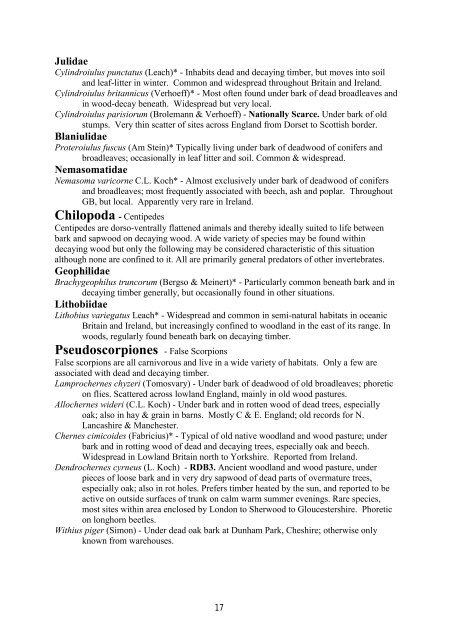Crustacea: Copepoda - Cerambycoidea.com
Crustacea: Copepoda - Cerambycoidea.com
Crustacea: Copepoda - Cerambycoidea.com
You also want an ePaper? Increase the reach of your titles
YUMPU automatically turns print PDFs into web optimized ePapers that Google loves.
Julidae<br />
Cylindroiulus punctatus (Leach)* - Inhabits dead and decaying timber, but moves into soil<br />
and leaf-litter in winter. Common and widespread throughout Britain and Ireland.<br />
Cylindroiulus britannicus (Verhoeff)* - Most often found under bark of dead broadleaves and<br />
in wood-decay beneath. Widespread but very local.<br />
Cylindroiulus parisiorum (Brolemann & Verhoeff) - Nationally Scarce. Under bark of old<br />
stumps. Very thin scatter of sites across England from Dorset to Scottish border.<br />
Blaniulidae<br />
Proteroiulus fuscus (Am Stein)* Typically living under bark of deadwood of conifers and<br />
broadleaves; occasionally in leaf litter and soil. Common & widespread.<br />
Nemasomatidae<br />
Nemasoma varicorne C.L. Koch* - Almost exclusively under bark of deadwood of conifers<br />
and broadleaves; most frequently associated with beech, ash and poplar. Throughout<br />
GB, but local. Apparently very rare in Ireland.<br />
Chilopoda - Centipedes<br />
Centipedes are dorso-ventrally flattened animals and thereby ideally suited to life between<br />
bark and sapwood on decaying wood. A wide variety of species may be found within<br />
decaying wood but only the following may be considered characteristic of this situation<br />
although none are confined to it. All are primarily general predators of other invertebrates.<br />
Geophilidae<br />
Brachygeophilus truncorum (Bergso & Meinert)* - Particularly <strong>com</strong>mon beneath bark and in<br />
decaying timber generally, but occasionally found in other situations.<br />
Lithobiidae<br />
Lithobius variegatus Leach* - Widespread and <strong>com</strong>mon in semi-natural habitats in oceanic<br />
Britain and Ireland, but increasingly confined to woodland in the east of its range. In<br />
woods, regularly found beneath bark on decaying timber.<br />
Pseudoscorpiones - False Scorpions<br />
False scorpions are all carnivorous and live in a wide variety of habitats. Only a few are<br />
associated with dead and decaying timber.<br />
Lamprochernes chyzeri (Tomosvary) - Under bark of deadwood of old broadleaves; phoretic<br />
on flies. Scattered across lowland England, mainly in old wood pastures.<br />
Allochernes wideri (C.L. Koch) - Under bark and in rotten wood of dead trees, especially<br />
oak; also in hay & grain in barns. Mostly C & E. England; old records for N.<br />
Lancashire & Manchester.<br />
Chernes cimicoides (Fabricius)* - Typical of old native woodland and wood pasture; under<br />
bark and in rotting wood of dead and decaying trees, especially oak and beech.<br />
Widespread in Lowland Britain north to Yorkshire. Reported from Ireland.<br />
Dendrochernes cyrneus (L. Koch) - RDB3. Ancient woodland and wood pasture, under<br />
pieces of loose bark and in very dry sapwood of dead parts of overmature trees,<br />
especially oak; also in rot holes. Prefers timber heated by the sun, and reported to be<br />
active on outside surfaces of trunk on calm warm summer evenings. Rare species,<br />
most sites within area enclosed by London to Sherwood to Gloucestershire. Phoretic<br />
on longhorn beetles.<br />
Withius piger (Simon) - Under dead oak bark at Dunham Park, Cheshire; otherwise only<br />
known from warehouses.<br />
17

















